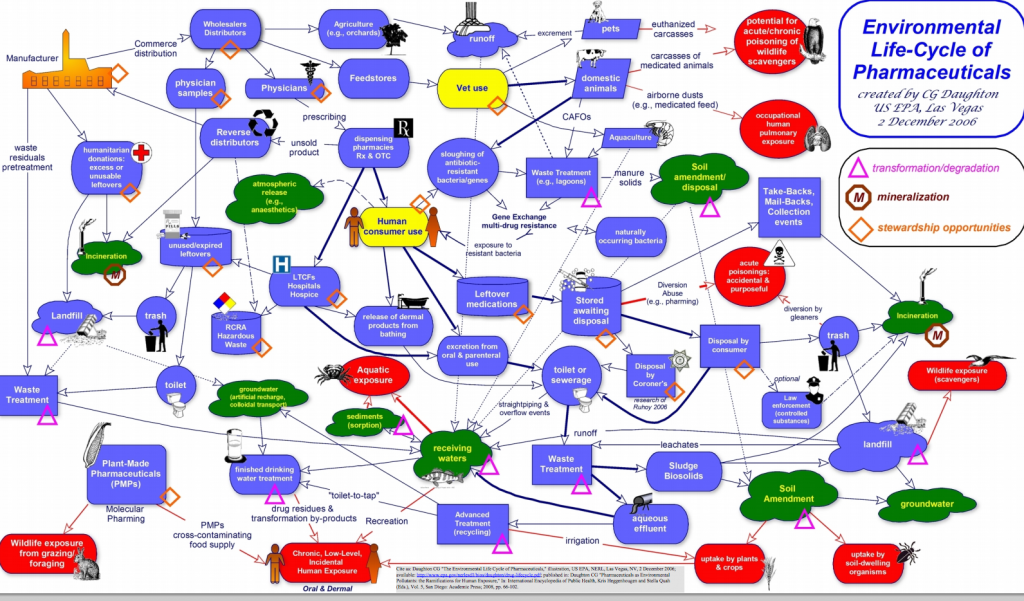 At ACSH, we are always on the lookout for bad headlines. Thanks to CBS News, we have a real beauty. It s so bad that, despite the fact there are more than 10 months left in the year, this one will come out on top (bottom?). It s that bad.
At ACSH, we are always on the lookout for bad headlines. Thanks to CBS News, we have a real beauty. It s so bad that, despite the fact there are more than 10 months left in the year, this one will come out on top (bottom?). It s that bad.
Here is their headline from February 11th: New York, New England groundwater teeming with pharmaceuticals.
It s unknown what CBS s intention was, but we can hazard a guess. Sensationalist headlines sure do get attention. This one is a beauty. And if the headline even remotely matched the actual science behind the story, approximately zero people would ever read it.
The CBS piece is not only misleading, but intentionally so. It implies that 1) We are consuming dangerous amounts of drugs when we drink water; 2) This is something new; and 3) There is something that can be done about it. All of these are false.
ACSH s Dr. Josh Bloom explains: This story is ridiculous on so many levels that I almost don t know where to start. First, the title alone conjures up the image that drinking a glass of water is like sitting in CVS with a funnel in your mouth and a line of pharmacists waiting to pour buckets of pills down your throat. After all, if our drinking water is teeming with drugs, how can we avoid consuming all of these poisons?
He adds, The word teeming couldn t be less inaccurate.The reality is that modern analytical techniques have advanced to the point where minuscule traces of just about anything can be found just about anywhere. This is not a new problem. In fact, it s neither new nor a problem. It is a function of better instrumentation, worse reporting, and a pervasive, irrational fear of chemicals that leads people to believe that we are all being slowly poisoned from accumulation of multiple drugs and chemicals. This is nonsense.
Our mantra at ACSH is The presence of a chemical says nothing about its risk. This is widely misunderstood, but in this case, no phrase applies better. Our bodies are exposed to tiny amounts of thousands of chemicals, both natural and man-made, every day. With rare exceptions, they do not stay around. Ironically, the reason that drugs do not accumulate in our bodies is the main point of the CBS article they are metabolized or excreted unchanged in the urine and feces. This is the main reason they are in our water.
To their credit, CBS does note that the quantities of these drugs are far below the level that could be of any harm to humans, but they also linked to a 2011 report from the General Accounting Office entitled, ENVIRONMENTAL HEALTH. Action Needed to Sustain Agencies Collaboration on Pharmaceuticals in Drinking Water. Indeed, the main thrust of the article is concern about what effect drugs might have on the marine environment. This is demonstrated by the following bit of insanity, courtesy of the EPA It is meant to demonstrate the fate of pharmaceuticals once they leave the manufacturing site.

Dr. Bloom comments, Not to belabor the obvious, but if you try to figure this out, you will almost certainly need more drugs probably antidepressants, anti-anxiety drugs, and Ritalin. Which, I guess in some way could make the problem worse. Try and tell me that this image is not reminiscent of Van Gogh's paintings as his mental health progressively deteriorated.
The bottom line is that this is not only a non-issue, but even if it were, what could we do about it? The answer is nothing.
Dr. Bloom explains, The only way to stop this non-problem is for people to stop taking medicine. If you think that proper disposal of unused drugs will make a difference, you are kidding yourself. The contribution from landfills is essentially zero. They are coming from your body. And no sewage treatment plant can do a thing about it. Of the hundreds (thousands?) of drugs that are regularly consumed, not one is entirely retained in your body. Sometimes more than 90 percent of a drug is excreted unchanged. And to make matters infinitely more complicated, most drugs undergo metabolism, primarily in the liver, and are thus converted to another chemical. A single drug can yield a dozen or more metabolites, which are excreted primarily in the urine. So, we are talking about thousands of compounds some of which are unknown in miniscule quantities that end up in sewers and septic systems that cannot possibly remove them. It would seem that all this study is doing is pissing away money.
Finally, let s give a special duh to Patrick Phillips, the lead author of the study, which was published in the journal Science of the Total Environment. He is concerned about the effect on the drugs on fish and other marine life. He says, The presence of these compounds such as antibiotics in measurable concentrations could mean that they are making it harder for the aquifer to remove nitrogen which then lowers the oxygen in the water and causes such things as algae blooms.
Which makes Dr. Bloom wonder, Is he really serious? Yes most antibiotics contain a few atoms of nitrogen. Possibly he should consider how much nitrogen that ends up in the water comes from runoff of fertilizers from lawns, crops, and golf courses. Algae blooms from antibiotics? Not on this planet.


